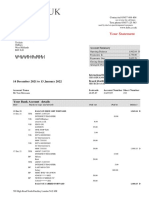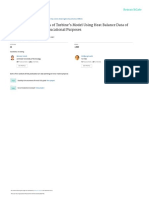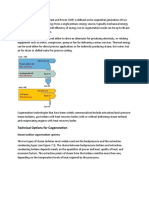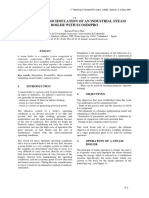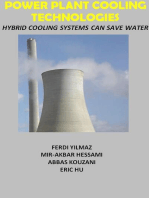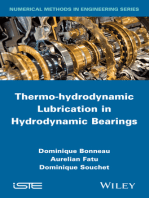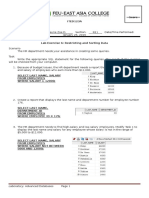Jimmy D Kumana, Consulting Engineer, Houston, Texas
Jimmy D Kumana, Consulting Engineer, Houston, Texas
Uploaded by
jkumanaCopyright:
Available Formats
Jimmy D Kumana, Consulting Engineer, Houston, Texas
Jimmy D Kumana, Consulting Engineer, Houston, Texas
Uploaded by
jkumanaOriginal Title
Copyright
Available Formats
Share this document
Did you find this document useful?
Is this content inappropriate?
Copyright:
Available Formats
Jimmy D Kumana, Consulting Engineer, Houston, Texas
Jimmy D Kumana, Consulting Engineer, Houston, Texas
Uploaded by
jkumanaCopyright:
Available Formats
USE SPREAD-SHEET BASED CHP MODELS to IDENTIFY and EVALUATE ENERGY COST
REDUCTION OPPORTUNITIES in INDUSTRIAL PLANTS.
Jimmy D Kumana, Consulting Engineer, Houston, Texas
jkumana@aol.com
ABSTRACT • Blowdown flash tanks
• Condensate recovery systems (steam traps,
CHP (for Combined Heat and Power) is fast separators)
becoming the internationally accepted terminology • Condensate mix tanks
for describing the energy utilities generation and • Deaerators
distribution systems in industrial plants. The term is • BFW pumps
all inclusive - boilers, fired heaters, steam turbines, • Back-pressure steam turbines
gas turbines, expanders, refrigeration systems, etc. • Pressure reducing stations
• Desuperheating stations
A simulation model of the CHP system is an
• Gas turbines, with or without heat recovery
extremely useful tool to understand the interactions
steam generators
between the various components. Applications
• Condensing steam turbines
include:
• Condensers
• identifying opportunities for cost reduction
through efficiency improvement • Cooling water circuits
• accurate energy cost accounting • Refrigeration systems (both mechanical and
absorption type)
• evaluating the energy cost impact of proposed
process changes on the demand side • etc
• comparison of cogeneration options
The interactions between these various
• identifying load shaping strategies (eg. switching
components can be very complex, and cannot be
between motors and turbine drives)
easily understood without constructing a reasonably
• negotiating fuel/power supply contracts accurate mathematical model.
This paper describes how CHP models can be
developed easily and at low cost using electronic CONSTRUCTING THE MODEL
spreadsheets, and illustrates their application with a
detailed example. A model is simply a set of equations and
constraints that establishes the quantitative
relationship between the key parameters of interest.
INTRODUCTION
Consider the CHP system for a pulp/paper mill, as
The “utilities” plant at an industrial depicted in Figure 1, which incorporates many of the
manufacturing facility should more properly be features found in a typical industrial facility.
called the Combined Heat and Power, or CHP,
system. This is the prevailing terminology used in The overall model has two distinct elements:
Europe and elsewhere in the world, and is
increasingly being adopted in the USA as well. The (a) models of individual items of equipment
CHP system includes all the elements involved in the (b) computational strategy for interactions between
generation and distribution of energy to drive the equipment, that also reflects the operating
process and supporting infrastructure: policy
• Fired boilers It is beyond the scope of this paper to describe all
• Waste heat boilers possible variations of equipment models, but some
• Combustion air preheaters selected examples will illustrate the available options
• Economizers (for BFW preheat) for the principal items.
23rd Industrial Energy Technology Conference, Houston, Tx (May 2001) page 1 of 8
Figure 1. Schematic Flowsheet of Combined Heat and Power System
23rd Industrial Energy Technology Conference, Houston, Tx (May 2001) page 2 of 8
Back-pressure steam turbine (simple)
Boiler model 1 (simple)
Operating mode = constant load and flow
Operating mode = base load, constant efficiency
Input parameters = Pi, Ti, Po, steam flow in (Klb/h),
Input parameters = max operating capacity, operating power output rate (kwh/Klb). The latter is calculated
pressure and temp, efficiency, blowdown rate (as % by the user from inlet and outlet pressures, inlet temp,
of steam generation), operating rate (% of max) and isentropic efficiency.
Equations: Equations:
1. Steam gen = capacity x operating rate 1. Power, kw = output rate x steam flow
2. Blowdown = fraction x steam gen rate 2. Hs,o = Hs,i – 3412/kw
3. Feedwater = stm gen + blowdown 3. To = f(Po, Hs,o), from steam props data base
4. Hs = f(P,T), from steam properties data base
5. Fuel input = Stm (Hs – hBFW)/η Back-pressure steam turbine (rigorous)
Boiler model 2 (simple) Operating mode = load following, variable flow
Operating mode = swing, variable efficiency Input parameters = Pi, Ti, Po, power output required,
linked to process model, turbine performance curve
Input parameters = max operating capacity, operating (from manufacturer’s data) that expresses the steam
pressure and temp, blowdown rate (as % of steam flow rate as a function of power output for the given
generation) Pi, Ti, and Po.
Equations: Equations:
1. Steam gen = Total steam production required 1. Steam flow = f(required power output)
(trial value in overall computational algorithm) – 2. Hs,o = Hs,i – 3412/kw
combined steam generated in all other boilers 3. To = f(Po, Hs,o), from steam props data base
2. Blowdown = fraction x steam gen rate
3. Feedwater = stm gen + blowdown Deaerator
4. Hs = f(P,T), from steam properties data base
5. Operating rate (%) = Stm gen / Capacity Operating mode = steady state (see Figure 2)
6. Efficiency η = f(operating rate), equation to be
provided by user, from manufacturer’s data Input parameters = condensate flow and temp from
7. Fuel input = Stm (Hs – hBFW)/η process, condensate flow and temp from condensing
steam turbine, economizer duty, pressure of steam
Boiler model 3 (rigorous) used in economizer, DA operating pressure, temp of
makeup water (after preheating), vent vapor flow
Operating mode = base load from DA
Input parameters = max operating capacity, operating Equations:
pressure and temp, blowdown rate (as % of steam 1. Combined condensate flow, C = process cond +
generation), operating rate (% of max), stack gas turbine condensate + economizer condensate
temp, combustion air supply temp, excess air ratio, 2. Mixed cond temp = sum (flow x temp) / sum
radiative and convective heat losses (flow)
3. Assume Hv = Hs (this simplifies the model
Equations: without significant error)
1. Steam gen = capacity x operating rate 4. BFW flow, B = sum (feedwater flows to boilers)
2. Blowdown = fraction x steam gen rate + sum (flows to desuperheating stations)
3. Feedwater = stm gen + blowdown 5. SDA = {C(hM – hC) + B(hB – hM)}/(Hs – hM) + V
4. Hs = f(P,T), from steam properties data base 6. Makeup to DA, M = B + V – C - SDA
5. Efficiency η = calculated from boiler heat and
material balance Other equipment
6. Fuel input = Stm (Hs – hBFW)/η
Similar models must be set up for the blowdown
flash tank, desuperheating stations, etc.
23rd Industrial Energy Technology Conference, Houston, Tx (May 2001) page 3 of 8
Process
Vent condensate
Steam Steam turbine condensate
BFW to
economizer
Utility condensate
from economizer
Deaerator
Deaerator Mixed condensate
tank
BFW pump
Process heat recovery
Cold DI water
makeup
Figure 2. Schematic of Deaerator and Auxiliary Equipment
Overall Algorithm 3. PRV flow from IP to MP = sum (steam inflows)
+ DSH stm - process demand – sum (turbine
Now we need to tie all the various parameters outflows)
together in an overall computational algorithm. It is 4. Calculate BFW flow to DSH station in MP
recommended that heat losses due to radiation and header by simultaneous material and heat
leaks be excluded from the model, as they add a balance
tremendous lot of computational complexity, make 5. PRV flow from MP to LP = sum (steam inflows)
the model extremely difficult to debug, and do not + DSH stm - process demand – sum (turbine
offer compensating benefits. The typical error is outflows)
about 3%, and this can be added on to the fuel cost. 6. Calculate BFW flow to DSH station in LP
header by simultaneous material and heat
Input parameters = operating pressure and temp of balance
the various steam headers, process steam demands at 7. Calculate flash vapor and net liquid blowdown
the various pressure levels, steam flow rates to the flows from the BD flash tank, by heat/mass
back-pressure and condensing turbines, condensate balance.
return rate (flow), DI makeup water supply temp, 8. Calculate steam and makeup water flows to the
estimated or allowable vent losses from LP header. DA from DA model
9. BFW temp = DA temp + economizer duty /B
Calculation sequence: 10. Vent flow from LP header to atmos = sum
Assume a trial value for total steam generation in (steam inflows) + DSH stm + flash vapor from
the boilers, and then calculate the various parametric BD tank - process demand – stm to DA
values from the “top down” by applying established 11. Heat recovery required against process hot
principles for steady-state material and energy streams = M x (DA feed temp – DI makeup
balances. water supply temp)
1. PRV flow from HP to IP = sum (steam from 12. Calculate total steam generation required in
boilers) - process demand – sum (turbine boilers = sum (process demands) + flow to
outflows) condensing path of steam turbine + steam to
2. Calculate BFW flow to DSH station in IP header economizer + DA steam – BD flash vapor – sum
by simultaneous material and heat balance (DSH flows) + LP vent to atmos
23rd Industrial Energy Technology Conference, Houston, Tx (May 2001) page 4 of 8
Compare the calculated steam generation The next idea we explore is to increase the duty
requirement with the assumed trial value, and iterate on the economizer, e.g. from 10 MMBtu/h to 30
until the two agree within the specified tolerance MMBtu/h. This will mean adding additional heat
limit (eg. 0.1 Klb/h). transfer surface. However, the model shows that the
cost savings are non-existent, because the
One note of caution – the user should be careful incremental power credit is almost exactly offset by
to ensure that the assumptions and data inputs do not the extra cost of fuel. Thus at current fuel and power
result in infeasible solutions, such as reverse flows (ie prices, there is no incentive to spend any engineering
from lower to higher pressure) across the PRV, and resources on repairing/revamping the economizer. In
violating capacity constraints on the boilers and fact, the model shows that the economizer could be
turbines. taken out of service with no penalty at all. This
insight would probably have been eluded us without
a model.
APPLICATIONS
Such preliminary screening allows us to focus on
Now let us consider some of the practical uses for the projects that are attractive, and cast aside ones
this model. that are not. We can simultaneously evaluate the
potential benefits of common energy conservation
First and foremost we compare the calculated and efficiency improvement measures such as
steam and power balance against measured (metered) increasing the condensate recovery rate, preheating
values. If the two are not in reasonable agreement it BFW makeup water to the DA, and reducing steam
means one of two things: consumption in the process through heat recovery.
(a) the meters need to be recalibrated
(b) the model is not an accurate representation of the For example, increasing condensate recovery
plant, and needs to be corrected from 56% to 70% saves 410 K/yr, adding an
exchanger to recover 5.5 MMBtu/h of heat from
The error could be in the physical configuration, boiler blowdown saves about $110K/yr, and further
or in the assumptions about operating policy and/or preheating BFW makeup by 26 MMBtu/h to 150°F
leaks and heat losses. (against process waste heat) saves another $190K/yr.
It may appear odd that the cost savings are not
Once the data have been reconciled, it is possible proportional to the heat recovery rate. This is
to begin analyzing the system for opportunities to because the reduction in steam generation comes
improve efficiency. The first thing we look for is from different boilers which have different
shifting flow from PRVs to steam turbine generators. efficiencies, an effect that would have been difficult
In Figure 1, we see that the PRV flows are already to predict without the model.
very small, and that the opportunity to make more
power in the back-pressure STs is limited. In recent years, cogeneration projects involving
gas turbines have become very popular. The model
We next turn our attention to condensing steam can be used to quickly check whether such a project
turbines. These are usually “Across the Pinch”, and would be appropriate for local site conditions. The
not cost effective for base load operation. The model key parameters (heat rate and steam/power ratio) for
shows however that if the condensing flow were the machine being considered must be provided as
reduced to the minimum of 20Klb/h, the operating input. The model shows that energy operating costs
cost would go UP by $630K per year, which is actually increase by $2.37 MM/yr, because the
counter to expectation. This is because the swing power:gas cost ratio is not favorable, and so this
fuel being used is coal (in power boiler #10), which is project can be immediately rejected without further
extremely cheap. waste of time.
If the swing fuel were gas, however, then the cost One must keep in mind that the foregoing
savings would be $910/yr, which is more typical, and conclusions are valid only for the fuel/power costs
would be accomplished by shutting down package and equipment capacity/efficiency numbers that have
boilers #5 and 6. The model shows that nearly a been used. Under a different set of technical and
million dollars a year (including maintenance and economic conditions, the optimum operating policy
operating labor cost savings) could be achieved by could be quite different. The estimated cost savings
minimizing flow through the condensing section of and key parameters for all of the various projects
the turbines, at zero capital cost. discussed above are summarized in Table 1.
23rd Industrial Energy Technology Conference, Houston, Tx (May 2001) page 5 of 8
Table 1: SUMMARY of COST SAVINGS from VARIOUS PROJECTS
Case Number
0 1 2 3 4 5 6 7 8
Economizer duty, MMBtu/h 10 10 10 30 0 10 10 10 10
Condensate recovery, % 56 56 56 56 56 70 70 70 70
DA feedwater temp, F 73 73 73 73 73 73 150 150 150
Heat rec into DFW, MMBtu/h 0 0 0 0 0 0 31.5 26.7 26.7
Process LP steam savings, Klb/h 0 0 0 0 0 0 0 200 200
Total boiler steam gen, Klb/h 1591 1479 1477 1494 1468 1439 1380 1270 1162
Fuel Consumed, MMBtu/h
Coal 607 450 545 557 538 492 409 86 8
Gas in boilers 98 98 0 0 0 0 0 0 0
Gas in Gas Turbine 0 0 0 0 0 0 0 0 248
Total 705 548 545 557 538 492 409 86 256
Turbogenerator steam flows
HP to IP 200 200 200 200 200 200 200 200 200
HP to MP 486 486 486 505 480 486 486 486 486
HP to LP 680 646 646 643 643 608 549 330 330
HP to condensing 100 20 20 20 20 20 20 20 20
Total 1466 1352 1352 1368 1343 1314 1255 1036 1036
Total power generated, MW 76.2 66.1 66.1 66.6 65.6 63.9 60.6 48.1 61.7
Operating cost, MM$/yr 17.22 17.85 16.31 16.32 16.32 15.91 15.61 14.56 16.93
Cumulative savings, MM$/yr 0 -0.63 0.91 0.90 0.90 1.31 1.61 2.66 0.29
Incremental savings, MM$/yr 0 -0.63 1.54 -0.01 0.00 0.41 0.30 1.05 -2.37
Case Number Description
0 Base case – existing operation
1 Minimize condensing turbine flow, cut back on coal fired boiler
2 Minimize condensing turbine flow, cut back on gas-fired boilers (can be shut down)
3 Increase economizer duty to 30 MMBtu/h
4 Reduce economizer duty to Zero
5 Increase condensate recovery from 56% to 70%
6 Raise DA feedwater temp to 150F by heat recovery against process
7 Reduce LP steam demand in process through heat recovery (Pinch Analysis)
8 Add new 15 MW Gas Turbine with HRSG, cut back on boiler steam production
Note: Numbers in BOLD in the table are the primary changes made in each case listed.
23rd Industrial Energy Technology Conference, Houston, Tx (May 2001) page 6 of 8
Finally, we can postulate various levels of steam Customers”, paper 6a presented at 19th Industrial
savings in the process, in steps of 50 Klb/h, and Energy Technology Conference, Houston, Tx
develop a curve showing the net cost savings and the (Apr 1997)
marginal cost of steam. Figure 3 shows the marginal
cost of steam savings is constant over the entire range 3. R Nath, J D Kumana and J F Holliday,
of 0-250 Klb/h, which is somewhat atypical. “Optimum Dispatching of Plant Utility Systems
Normally, there will be several step changes in the to Minimize Cost and Local NOx Emissions”,
marginal cost curve, reflecting changes in fuel mix Proc of ASME’s Industrial Power Conference,
(eg. gas vs coal) and boiler efficiency as the high cost New Orleans, La (Mar 1992)
boilers are shut down, changes in steam path (eg.
PRV versus ST) due to capacity limitations, or NOMENCLATURE
changes in power cost structure as due to contractual
constraints. H enthalpy of steam
h enthalpy of liquid
It is important to recognize that the cost savings kw kilowatts
achieved are a function of the order in which the kwh kilowatt-hours
projects are implemented. Generally, the earlier P pressure
projects will have proportionately larger savings, and S steam (flow parameter)
the later ones will have smaller savings. T temperature
V vapor (flow parameter)
One of the most powerful applications of such η efficiency, %
models is their use for on-line real time optimization
of the operating policy for the CHP system. This has ABBREVIATIONS
been done at many of the manufacturing sites owned
by progressive companies like Union Carbide, BASF, BD blowdown
and Chevron. BFW boiler feed water
DA deaerator
CONCLUSIONS DI De-ionized (water)
DSH desuperheating
CHP simulation models are a convenient and HP high pressure
reliable tool to evaluate ideas for efficiency i inlet (as subscript)
improvement and cost reduction. They provide IP intermediate pressure
accurate estimates of operating costs, and can be used K 1000
for online real-time optimization. L liquid (as subscript)
LP low-pressure
The cost of developing a model using electronic MM million
spreadsheets is very modest (in the range of $10 – MP medium pressure
20K, depending on complexity) compared to the o outlet (as subscript)
potential benefits. PRV pressure reducing valve
S steam (as subscript)
It is recommended that this tool be adopted by ST steam turbine
industry for energy cost accounting and to improve V vapor (as subscript)
energy efficiency, with attendant reduction in
operating cost and emissions of greenhouse gases to ABOUT THE AUTHOR
the environment.
Mr. Kumana has a Masters degree in chemical
REFERENCES engineering from the University of Cincinnati. He
has been a consultant in the field of process
1. J D Kumana, “CHP Models for Energy modeling, design and optimization for 30 years,
Optimization”, invited paper presented at Pfizer specializing in energy and water conservation. He
Process Engineering Conference, Boston, Ma was previously employed with Union Carbide, HDR
(Oct 26th, 2000) and Linnhoff March Inc. He has over 50 publications
to his credit, and taught the AIChE course on Process
2. J D Kumana, F J Alanis, A L Swad and J V Integration (Pinch Analysis) for many years. He can
Shah, “CHP Modeling as a Tool for Electric be reached at 713-957-1125 or jkumana@aol.com
Power Utilities to Understand Major Industrial
23rd Industrial Energy Technology Conference, Houston, Tx (May 2001) page 7 of 8
CHP operating costs
18 1.0
Misc design Op Cost
17 changes, cases 1-6
Marginal cost
Operating Cost, MM$/yr
Margnal cost, $/Klb
16 0.8
15
14 0.6
13
12 0.4
0 50 100 150 200 250 300
Process Steam Savings, Klb/h
Figure 3: Operating Cost Savings and Marginal Cost of Steam
23rd Industrial Energy Technology Conference, Houston, Tx (May 2001) page 8 of 8
You might also like
- Air Cooled Heat Exchanger Handbook: Fundamentals, Calculations, Design and Q&AFrom EverandAir Cooled Heat Exchanger Handbook: Fundamentals, Calculations, Design and Q&ANo ratings yet
- Essentials of Steam Turbine Design and Analysis: Back To BasicsDocument9 pagesEssentials of Steam Turbine Design and Analysis: Back To BasicsJohn AnthoniNo ratings yet
- 2022 01 13 - StatementDocument8 pages2022 01 13 - StatementToni MirosanuNo ratings yet
- Excel Software As A ToolDocument20 pagesExcel Software As A ToolsvvsnrajuNo ratings yet
- Process Integration (PI)Document180 pagesProcess Integration (PI)Abrhsh67% (3)
- Process Integration LectureDocument93 pagesProcess Integration LectureBereket TeferaNo ratings yet
- Process Integration (PI) .Power PointDocument100 pagesProcess Integration (PI) .Power PointAbrhshNo ratings yet
- A Thermo-Economic Analysis of Working Fluid and Cycle Combinations For Industrial Heat Pump ApplicationsDocument14 pagesA Thermo-Economic Analysis of Working Fluid and Cycle Combinations For Industrial Heat Pump Applicationsjuan bernalNo ratings yet
- Steam Turbine Power Plant DesignDocument52 pagesSteam Turbine Power Plant DesignykeinNo ratings yet
- Dimensioning and Evaluating A Multi-Channel Thermoelectric Generator Using A Costumized Simulation ArchitectureDocument19 pagesDimensioning and Evaluating A Multi-Channel Thermoelectric Generator Using A Costumized Simulation ArchitectureBenny Wahyudi 1707110943No ratings yet
- C5008098319 PDFDocument5 pagesC5008098319 PDFRamkishan SahuNo ratings yet
- Determining Parameters of Turbine's Model Using Heat Balance Data of Steam Power Unit For Educational PurposesDocument8 pagesDetermining Parameters of Turbine's Model Using Heat Balance Data of Steam Power Unit For Educational PurposesRezki NasutionNo ratings yet
- Pso 1Document4 pagesPso 1OMKAR PATILNo ratings yet
- Cog en Era Ti OnDocument12 pagesCog en Era Ti OnMayank DubeyNo ratings yet
- Chapter 3 - Heat IntegrationDocument25 pagesChapter 3 - Heat IntegrationAmeerRashidNo ratings yet
- 1 Process Integration Lecture 1Document32 pages1 Process Integration Lecture 1yonas simur100% (1)
- Boiler-Turbine Simulator With Real-Time Capability For Dispatcher Training Using LabviewDocument7 pagesBoiler-Turbine Simulator With Real-Time Capability For Dispatcher Training Using LabviewraitoNo ratings yet
- PinchDocument14 pagesPinchYounes AgrouazNo ratings yet
- 4 3 CogenerationDocument10 pages4 3 CogenerationJayvin RossNo ratings yet
- Energy Integration of Fired Heaters Into Overall Processes: James Varghese and Santanu BandyopadhyayDocument24 pagesEnergy Integration of Fired Heaters Into Overall Processes: James Varghese and Santanu BandyopadhyayJesse Haney IIINo ratings yet
- CCPP Start Up SIx Equation ModelDocument17 pagesCCPP Start Up SIx Equation ModelJung Kyung WooNo ratings yet
- Optimization of Combined Cycle Power Plants Using Evolutionary AlgorithmsDocument9 pagesOptimization of Combined Cycle Power Plants Using Evolutionary Algorithmsjhugo_mirandaNo ratings yet
- Thermodynamic Analysis For Performance Improvement of Power Plant by Flue Gas Heat Recovery SystemDocument10 pagesThermodynamic Analysis For Performance Improvement of Power Plant by Flue Gas Heat Recovery SystemTJPRC PublicationsNo ratings yet
- Thermal Analysis of Waste Heat Recovery Unit Using The Exhaust Gas Emitted From Internal Combustion EngineDocument6 pagesThermal Analysis of Waste Heat Recovery Unit Using The Exhaust Gas Emitted From Internal Combustion EngineAmal RajNo ratings yet
- Essentials of Steam Turbine Design and Analysis - AIChEDocument13 pagesEssentials of Steam Turbine Design and Analysis - AIChEHafiz Bilal AhmadNo ratings yet
- High Temperature Compact Heat Exchangers: Performance of Advanced Metallic Recuperators For Power PlantsDocument9 pagesHigh Temperature Compact Heat Exchangers: Performance of Advanced Metallic Recuperators For Power PlantsdfvgdfvdfvdsvsfsdasdvNo ratings yet
- Integration of A Gas Turbine With An Ammonia Process For Improving Energy EfficiencyDocument11 pagesIntegration of A Gas Turbine With An Ammonia Process For Improving Energy EfficiencynguyentuNo ratings yet
- 01338475Document6 pages01338475api-3697505No ratings yet
- JETIR1806098Document5 pagesJETIR1806098Belay AyalewNo ratings yet
- Simulation of Power Plants by ExcelDocument19 pagesSimulation of Power Plants by ExcelAbd Elrahman HamdyNo ratings yet
- Research PaperDocument3 pagesResearch PapersalihyassinNo ratings yet
- 1 s2.0 S1876610215026375 MainDocument8 pages1 s2.0 S1876610215026375 Mainmuhammadwaleedfazal9No ratings yet
- Dynamic Simulation and Optimization of Start-Up ProcessesDocument7 pagesDynamic Simulation and Optimization of Start-Up Processeslxz861020No ratings yet
- Process Integration Through Pinch AnalysisDocument7 pagesProcess Integration Through Pinch AnalysisCORNELIUS CHIRUMENo ratings yet
- How To Calculate Thermodynamics For ORCDocument11 pagesHow To Calculate Thermodynamics For ORCWolfNo ratings yet
- Performance Evaluation of Combined Heat and Power PDFDocument9 pagesPerformance Evaluation of Combined Heat and Power PDFAbd Elrahman HamdyNo ratings yet
- Modelling and Simulation of An Industrial Steam Boiler With EcosimproDocument10 pagesModelling and Simulation of An Industrial Steam Boiler With EcosimproHENRY DAVID PURUNCAJAS PAUCARNo ratings yet
- MNLP (I.e., MINLP) Model For Optimal Synthesis and Operation of Utility PlantsDocument35 pagesMNLP (I.e., MINLP) Model For Optimal Synthesis and Operation of Utility PlantsErhan OğuşNo ratings yet
- Cost of SteamDocument13 pagesCost of SteamAlouis MutimboNo ratings yet
- Thermodinamic AnalysysDocument13 pagesThermodinamic AnalysysLeandro BuosiNo ratings yet
- Design and Optimization of Steam Distribution Systems For Steam Power PlantsDocument13 pagesDesign and Optimization of Steam Distribution Systems For Steam Power Plantssum74316No ratings yet
- Steam Turbinea NalysisDocument10 pagesSteam Turbinea NalysiswasayNo ratings yet
- Pinch Technology: Minahil Qumreen 2015-CH-430Document38 pagesPinch Technology: Minahil Qumreen 2015-CH-430adnan100% (2)
- Energy Conversion and ManagementDocument14 pagesEnergy Conversion and Managementnavas1972No ratings yet
- 1.0 Introduction:-: (Figure 1.1: Conventional Automotive Exhaust System)Document6 pages1.0 Introduction:-: (Figure 1.1: Conventional Automotive Exhaust System)The 10 TurretsNo ratings yet
- Araiz ProspectsWasteDocument15 pagesAraiz ProspectsWasteghoni48041.pesonaxxiNo ratings yet
- Combined Cooling, Heating, and Power Systems: Modeling, Optimization, and OperationFrom EverandCombined Cooling, Heating, and Power Systems: Modeling, Optimization, and OperationNo ratings yet
- Sustainable Energy Conversion for Electricity and Coproducts: Principles, Technologies, and EquipmentFrom EverandSustainable Energy Conversion for Electricity and Coproducts: Principles, Technologies, and EquipmentNo ratings yet
- Energy and Thermal Management, Air-Conditioning, and Waste Heat Utilization: 2nd ETA Conference, November 22-23, 2018, Berlin, GermanyFrom EverandEnergy and Thermal Management, Air-Conditioning, and Waste Heat Utilization: 2nd ETA Conference, November 22-23, 2018, Berlin, GermanyChristine JuniorNo ratings yet
- The Steam Engine and Turbine - A Text Book for Engineering CollegesFrom EverandThe Steam Engine and Turbine - A Text Book for Engineering CollegesNo ratings yet
- Process Steam Systems: A Practical Guide for Operators, Maintainers, and DesignersFrom EverandProcess Steam Systems: A Practical Guide for Operators, Maintainers, and DesignersNo ratings yet
- A Polygeneration Process Concept for Hybrid Solar and Biomass Power Plant: Simulation, Modelling, and OptimizationFrom EverandA Polygeneration Process Concept for Hybrid Solar and Biomass Power Plant: Simulation, Modelling, and OptimizationNo ratings yet
- Process System Value and Exergoeconomic Performance of Captive Power PlantsFrom EverandProcess System Value and Exergoeconomic Performance of Captive Power PlantsNo ratings yet
- Renewable Energy Engineering: Solar, Wind, Biomass, Hydrogen and Geothermal Energy SystemsFrom EverandRenewable Energy Engineering: Solar, Wind, Biomass, Hydrogen and Geothermal Energy SystemsNo ratings yet
- FAQ OS ManagementDocument3 pagesFAQ OS ManagementdvnasnsNo ratings yet
- JSTREET Volume 325Document10 pagesJSTREET Volume 325JhaveritradeNo ratings yet
- Guidelines For Science Fair Log BookDocument26 pagesGuidelines For Science Fair Log BookAnton Colasi CorulloNo ratings yet
- Shahid Bin LatifDocument3 pagesShahid Bin LatifMuhammad Shahid LatifNo ratings yet
- 9999 9999 263 en-GBDocument292 pages9999 9999 263 en-GBSalih PehlivanNo ratings yet
- Finlatics Investment Banking Experience ProgramDocument3 pagesFinlatics Investment Banking Experience ProgramShalaka PhatakNo ratings yet
- Decision OP: Damage & Needs AssessmentDocument4 pagesDecision OP: Damage & Needs AssessmentJulius de la CruzNo ratings yet
- Political Caricature During American PeriodDocument38 pagesPolitical Caricature During American Periodtri shia100% (1)
- Reece, Haley PDFDocument5 pagesReece, Haley PDFHaley ReeceNo ratings yet
- Groupe Renault - CSR V2020Document7 pagesGroupe Renault - CSR V2020OBSC PerfectionNo ratings yet
- Colton Furniture Co Is A Small But Fast Growing Manufacturer ofDocument1 pageColton Furniture Co Is A Small But Fast Growing Manufacturer ofAmit PandeyNo ratings yet
- Tesla Model 3 - Emergency First Responders Guide.Document31 pagesTesla Model 3 - Emergency First Responders Guide.Iqtidar A100% (1)
- An Organization Study at Strides Pharma Limited 2Document59 pagesAn Organization Study at Strides Pharma Limited 2Harshith KNo ratings yet
- Audit Planning and ManagementDocument3 pagesAudit Planning and ManagementcotwancoNo ratings yet
- Molecular Diagnostics by Frank F. Bier, Soeren Schumacher (Auth.), Harald Seitz, Sarah Schumacher (Eds.)Document176 pagesMolecular Diagnostics by Frank F. Bier, Soeren Schumacher (Auth.), Harald Seitz, Sarah Schumacher (Eds.)Héctor Molina100% (2)
- Lesson 11 - Innovation and EntrepreneurshipDocument32 pagesLesson 11 - Innovation and EntrepreneurshipsurangauorNo ratings yet
- Gloster Flexible LP - CDRDocument7 pagesGloster Flexible LP - CDRSamarendu BaulNo ratings yet
- Challenges in The Pathophysiology, Diagnosis, and ManagementDocument6 pagesChallenges in The Pathophysiology, Diagnosis, and Managementkatia.abushihabNo ratings yet
- Worldwide Regulated Open-End Fund Assets and Flows - First Quarter 2020Document46 pagesWorldwide Regulated Open-End Fund Assets and Flows - First Quarter 2020ace hoodNo ratings yet
- SPE-180376-MS Optimization of CO - EOR Process in Partially Depleted Oil ReservoirsDocument17 pagesSPE-180376-MS Optimization of CO - EOR Process in Partially Depleted Oil Reservoirsoppai.gaijinNo ratings yet
- Case Analysis: Mcdonalds in IndiaDocument12 pagesCase Analysis: Mcdonalds in IndiaNazifa AfrozeNo ratings yet
- Manchester Tank S Tanks Cylinders For LPG Systems 100 LB To 420 LB E92249a9 PDFDocument2 pagesManchester Tank S Tanks Cylinders For LPG Systems 100 LB To 420 LB E92249a9 PDFHarits MugniNo ratings yet
- Documentation and Comparison of Street Design of Pune and PCMCDocument4 pagesDocumentation and Comparison of Street Design of Pune and PCMC10Aboli MahajanNo ratings yet
- Lab6 - Restricting and Sorting DataDocument5 pagesLab6 - Restricting and Sorting Datatakuhibari7No ratings yet
- Oracle Applications R12: Date: Place: Kuala Lumpur Time: By: VaraprasadDocument43 pagesOracle Applications R12: Date: Place: Kuala Lumpur Time: By: VaraprasadVara ManiNo ratings yet
- Biomed Co. LTD: Designing A New: Sales Compensation PlanDocument13 pagesBiomed Co. LTD: Designing A New: Sales Compensation Plansumitshuklas144No ratings yet
- Sinterformteile MIM EnglDocument12 pagesSinterformteile MIM EnglMatija BušićNo ratings yet
- LCCI Kidolgozott Szobeli Tetelek 1Document55 pagesLCCI Kidolgozott Szobeli Tetelek 1zsuzsi_harangoz2218100% (2)
- RES505 Research MethodologyDocument410 pagesRES505 Research MethodologySatoshi amamotoNo ratings yet


